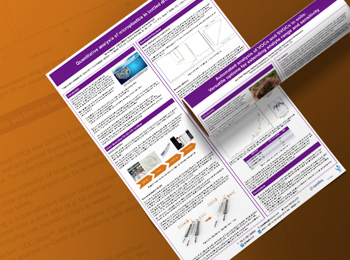
Selecting a HiSorb™ phase type for your application
11 July 2024
In an article I wrote and posted on LinkedIn, I described the main benefits of HiSorb™ high-capacity sorptive extraction probes, namely the high sorptive capacity and robust, easy-to-handle design coupled with full automation on the Centri extraction and enrichment platform. In that article, I touched on how you can select the right probe for your application. In this post, I go into more detail on an important aspect of that selection – choice of sorptive phase.
For sorbent selection using our probes, we have 4 alternate phase combinations:

- Polydimethylsiloxane (PDMS) - Crosslinked polymer, non-polar phase.
- PDMS with carbon wide range (CWR/PDMS) - Mesoporous structure, bipolar phase.
- PDMS with divinylbenzene (DVB/PDMS) - Highly electron-rich structure, bipolar phase.
- A combined triple phase (DVB/CWR/PDMS) - Largest compound range/volatility, bipolar phase.1
However, there are factors that need to be considered before choosing a phase for your application, these include:
Polarity
Polarity of target analytes can be easily determined by the compound octanol/water coefficient, also known as the logK(o/w) value.2 Generally if this value is >3, then the compounds usually prefer a non-polar phase type, such as Polydimethylsiloxane (PDMS). Adsorptive phases are preferred for polar analytes that typically have a logK(o/w) value of <3, such as carbon wide range (CWR) due to its graphitic mesoporous structure. Knowing the logK(o/w) of your compounds, or range of compounds, can help you decide which phase type may be optimal for the most efficient extraction.
During our preliminary phase evaluation, we analysed a range of compounds with varying polarity and functional groups. In the figure below, you can see the compounds on the x-axis. The black dashed line represents extraction of these compounds using a PDMS-only phase, which was normalised to 100% on the left axis. On the right axis, we have log Ko/w, which in the graph, is depicted as the red trend across the different compounds.
What this shows, is the increase in the amount of each analyte that was extracted using different phase combinations on HiSorb probes. We see a marked improvement for compounds with a log Ko/w < 3 and those with functional groups like the nonanal and dicyclohexylamine, which have a higher log Ko/w.
In some cases, you can see a dual-phase probe performs better than a triple phase. With the same total volume of phase applied to the probes, a lower amount of each of the phases will be added, particularly in the triple phase, which would confirm why there is a small drop in extraction for certain compounds, such as 1-octanol, when using the triple phase probe compared to a dual-phase probe. This highlights that more phases doesn't always extract more compounds.

Volatility
Depending on the volatility of analytes, phase selection can be key to optimising extraction efficiency. Due to its mesoporous structure, CWR is good for extracting very volatile components that are typically found to have low molecular weights (Mr) without issue of irreversible adsorption, as the volume of micropores present in the structure is very low. If your target analytes are large semi-volatile organic compounds (SVOCs) or aromatic, DVB might be a viable option, due to its highly electron-rich and its macro/mesoporous structure3,4. PDMS, as previously mentioned has an absorptive structure, which is usually better for extracting non-polar volatiles. Combining these phase types into our triple phase HiSorb probe can therefore expand your volatility range, great for untargeted analysis.
To help determine which phase would optimise your extraction based on the Mr of your compounds of interest, check out this handy graphic below3:

Applications
In some cases it may be necessary to trial multiple phase combinations as part of method development, comparing the performance of each to determine the most appropriate probe for the application. For example, three phase combinations were trialled in the aroma profiling of honey , assessing performance by the number of compounds detected and confidently identified. As you can see from the Venn diagram below, the addition of extra phases beyond PDMS alone let to the identification of substantially more compounds, with the triple phase probe (DVB/CWR/PDMS) providing the best results.

You can read about a similar process in this application note describing phase optimisation for the flavour profiling of hard seltzer alcoholic drinks.
To find out what else can be achieved using HiSorb and the Centri automated sample extraction platform, head over to our content hub where you can take a peak in our applications guide to see if we’ve already analysed something you’re working on.
If you can’t find what you’re looking for, please get in touch.
References
- https://www.ncbi.nlm.nih.gov/pmc/articles/PMC8659239/#B31-molecules-26-07409
- https://www.chemsafetypro.com/Topics/CRA/n_Octanol_Water_Partition_Coefficient_Kow.html
- https://www.mdpi.com/2297-8739/7/1/12
- https://www.sigmaaldrich.com/deepweb/assets/sigmaaldrich/product/documents/415/395/spme-gc-analysis-br1410en-mk.pdf




![Markes TD Brochure Hero3 Corepurple[2]](/media/zmscvqds/markes-td-brochure-hero3-corepurple-2.jpg?cc=0.55128205128205132,0,0,0&width=350&height=260&v=1d660d04edbcca0)




